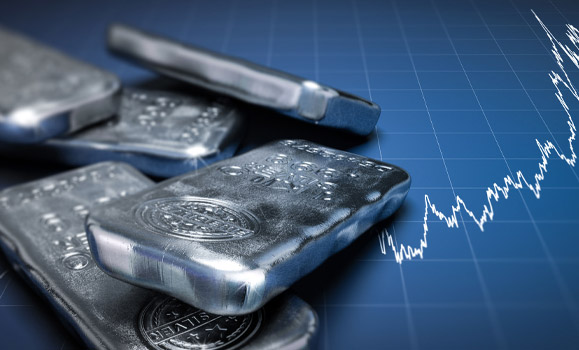
Silver Prices Over The Past Decade
With all the day to day volatility of global markets, sometimes it’s useful to get some perspective on things. Even though it is good to keep up with the latest live gold price and the latest silver price, seeing the long-term trend can be even more valuable from an investing perspective.
Silver is regarded as one of the safe-haven assets. This is because it has helped people maintain and grow their wealth, during good times and bad. For this reason, it functions much like gold — however, there are differences.
The silver market is more turbulent than gold. This is due to the market being much smaller in value than gold, with silver having lower market liquidity. There are also fluctuations in industrial demand. However, some believe this presents an opportunity in the silver market.
The price of silver UK is currently around £19.30 per ounce, and the gold price today is around £1,286. If the gold price increased by £19, it would be a 1.5% increase, but for silver, it would be a 100% increase. If you believe that precious metals, over the long term, are going to continue climbing, then silver has a lot of potential.
2011: A Sign of Things To Come
If you are sceptical about how much potential there is in silver, consider this: back in 2010, silver was at £9.76 per ounce, and by 2011 silver hit £25.87 — it practically tripled in one year.
This was the result of several financial and economic factors. There was the US debt-ceiling crisis, which damaged consumer confidence, affecting the US government’s credit rating. In addition to this was the ongoing economic crisis, and there was a lot of quantitative easing going on.
2012: Fluctuations and Growing Demand
Throughout 2012, the price of silver fluctuated considerably, as you can see here. The economic situation was starting to improve, and the US decided to increase its debt ceiling by $1.3bn, which helped restore confidence in the country.
2013: Consolidation
In 2013, silver began its consolidation. With the financial crisis gradually falling behind and with the US debt ceiling crisis becoming irrelevant due to the frequently climbing debt ceiling, the panic subsided and silver began retracing.
April saw a sharp decline in both gold and silver. This was due to concerns about the Federal Reserve’s monetary policy and the potential changes that were expected at the time.
Even though silver pulled back in price, it never returned to the levels seen before the financial crisis, and it has not done so ever since.
2016: The Bounce
With dropping oil prices and a falling stock market, investors sought refuge in precious metals. This saw silver rise from a low of £9.23 in December 2015 to £15.16 by July 2016.
You can view the history of gold and silver on our website. Our charts go back 50 years, showing you the long-term path of both precious metals. You can view the silver price chart here, and you can view the price of gold here.
2017: High Demand
During 2017, the silver price was steady and traded most of the year between £12.50 and £15 per ounce. With the global economy improving, the silver price became more stable.
The ongoing shift to renewable technology led to record-setting demand for silver, hitting 92 million ounces. Alongside the growth in demand was a decrease in mining supply, dropping for the first time in fourteen years.
2018: Peaks and Troughs
Silver’s price was wave-like throughout 2018, rising and falling. However the price changes were slow and gradual, and the price ranged between £11.20 and £12.50. Silver continued to stay steady until early 2019.
2019: Progress
By 2019, silver returned to its upward path. Starting the year at around £11.60, silver climbed over 26%, reaching £14.68 and setting a three-year high. There was a small retracement towards the end of the year, but this did not last long, and silver continued rising upwards into 2020.
2020: Global Shock
Silver continued performing well in early 2020. But with the start of the global pandemic and with lockdowns being imposed around the world, silver dropped from £14.31 in late February to £10.25 by mid-March, an absolute bargain.
Silver then rebounded just as quickly, reaching the previous high by May, and then silver rocketed on through the year, hitting £21 in September, an eight-year high. Within six months, silver had doubled in price. For the rest of the year, it traded in a range between £17.00 and £20.00. You can track the silver price here.
2021: Demand Soars
In January, large groups of investors decided to simultaneously invest in GameStop, multiplying its price almost thirty times in a matter of days. Silver then appeared to be next on the list for these groups of traders.
At the start of February, silver jumped 11.5% in a single day, setting an eight-year high. The rise led to many other investors jumping on board, including large retail investors.
Since April, the silver price has continued climbing from £17.90 to the present level of £19.40. This could be the year of silver — many expect demand to continue rising as national economies reopen, and some economists think that silver may rise even faster than gold.
Every Crisis Has a Silver Lining
Since the 1970s, silver has been on a long upward trend, and since 2003 that upward trend has increased almost exponentially. There have been spikes and retracements, but with consistently higher lows, silver now has a strong upward trajectory.
At UK Bullion, we offer market-leading prices for all our bullion. With bullion coins and bars from fractions of an ounce to multiple kilos, we’ve got something to suit your budget — invest now.

+ There are no comments
Add yours